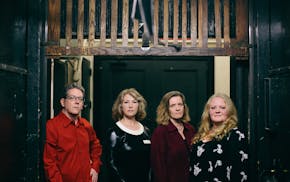Deaths in Minnesota day cares have declined since bereaved parents brought attention to the problem a decade ago, but preventable tragedies still occur when licensed providers ignore safe sleep and supervision rules that protect children.
Nine-month-old Zander Miller died in late 2019 after he was found with a worn-out blanket cinched around his neck at his Brainerd day care. Provider Mindy Koering failed to put him in a crib free of choking hazards, state records show, and then tried to cover up that she was caring for more children than the state considered safe.
Prior concerns about the day care prompted mother Ande Miller to pull her two children out for a week, but she sent them back. Zander died a month later.
"I had no other option," she said in an interview this week. "I needed to work."
A Star Tribune series in 2012 found that overcrowding and unsafe sleeping environments were contributing to nearly one death per month in licensed care in Minnesota. A decade after those stories led to reforms, stricter regulation and greater attention by providers have helped.
Deaths in licensed child care declined from 10 in 2011 to four in 2022. One child died each year in 2020 and 2021, when the COVID-19 pandemic kept families at home.
The challenge is to stamp out remaining violations that threaten children without overtaxing a child-care industry in Minnesota that is under stress. The number of licensed family child-care providers has declined from 10,000 in 2014 to 6,600 last year — eroding a key resource for rural and lower-income working families. The opening of school-like centers has maintained the state's overall capacity, but it has centralized child care in larger cities.
"There has always been a natural churn in the field" of family day cares closing, said Ann McCully, executive director at Child Care Aware of Minnesota, which provides training and support for providers and ranks them on ParentAware. "The difference now is you don't see as many new people stepping in."
While serious injuries are spread proportionately across different types of licensed child care, deaths are concentrated in family homes — where single providers watch over as many as 10 to 12 children. Family homes provided less than half of Minnesota's licensed child-care slots in 2020, but they accounted for 27 of 31 child-care deaths from 2013 through 2022.
Some deaths result from unavoidable accidents or underlying health problems rather than provider errors. Six of eight homes where children died since 2018 have active licenses, though one was cited for being over capacity, according to the Minnesota Department of Human Services. Koering's license was revoked while another no longer appears on the state's licensure website.
"The death of a child is always heartbreaking," said a statement from the state agency, which oversees county inspections of licensed family child care. "When it happens in a child care setting, we work with our partners to critically review what happened."
Miller briefly withdrew her children from Koering's day care over concerns that they weren't receiving enough supervision and were coming home with soiled diapers and rashes. Investigations later discovered that the day care was operating beyond its licensed capacity of 10 children.
Koering was watching 11 children on the day Zander died. She asked a parent to pick one up and didn't disclose that to authorities, according to the order revoking her license. The provider left Zander in a crib with a blanket and sippy cup for two hours, Miller said. Koering could not be reached for this article.
"Any time he would make a noise in his crib [at home], I would be right there checking on him," Miller said. "I had assumed that she would too."
Miller learned that her son had been found unresponsive at day care when a sheriff's deputy showed up at her door and told her to go to the hospital. An autopsy later found that asphyxiation caused her son's death.
After that, Miller said she couldn't trust any paid provider with her daughter or the son born after Zander's death. She stayed at home with the children until her mother agreed to watch them while she returned to work.
"I don't want him to be forgotten by anybody," she said of Zander, "and if telling his story can help prevent another infant death or anything like that, then I would be all for that."
State leaders believe the decline in deaths came through increased training and awareness of safe sleep practices and a crackdown on overcrowded day cares. Lawmakers in 2014 also required a doctor's note in order for day cares to deviate from the standard practice of putting infants on their backs, which has been associated with a reduction in infant deaths.
The Legislature this year updated child-care safety regulations by clarifying that hoods and bibs present hazards to sleeping infants. The guidance also outlined the appropriate use of pacifiers and swaddling as well as cradleboards for Native American and others who use them instead of cribs.
Lawmakers mostly focused on financial supports for a struggling industry, including the conversion of payments that kept providers afloat during the COVID-19 pandemic into annual incentives to improve their staffing levels and capacity. The state also increased subsidies to help low-income families, based on a new goal to prevent child care from consuming more than 7% of a family's income.
McCully said those investments could do more to boost safety if they attract and retain good caregivers and give parents the financial flexibility to pick the best providers.
"The effort really to uplift this workforce is going to do more for health and safety than anything else," she said.
Regulatory action has remained constant since 2019, with the state revoking the licenses of 15 to 20 family child-care facilities per year that hurt children or put them at risk. The revocation orders offer sad details of providers drinking or falling asleep, using corporal punishment, or losing children who ran miles away.
Advocates stress that violators are the minority. More than 1,000 licensed family child cares have been evaluated by ParentAware, and 426 have earned top four-star rankings, meaning they are effective at getting children developmentally ready for kindergarten.
Special report
The day care threat

The 5 best things our food writers ate this week

A Minnesota field guide to snow shovels: Which one's best?

Summer Camp Guide: Find your best ones here

Lowertown St. Paul losing another restaurant as Dark Horse announces closing
